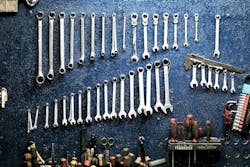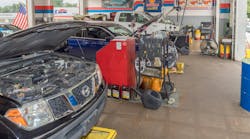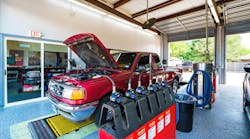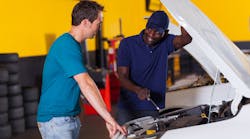SHOP STATS: Quality Tune Up Location: 6 in Sacramento, Calif. Operator: Tom McVey Average Daily Car Count: 20 Average Staff Size: 5-6 Average Shop Size: 1,400 square feet Ticket Average: $150
First impressions are everything, as they say. While not all quick lubes have a waiting room, many are starting to evolve their models to provide more full-service options. And with this requires more time spent at a quick lube shop.
Take Quality Tune Up, for example. The quick lube operation started off as a go-to for oil changes, tune ups, and smog checks. But as time went on, the company evolved into a full-service operation, adding brake, transmission, and many other maintenance services to its menu. Now, it can take an hour or two before a car gets done, according to Tom McVey, franchiser of six Quality Tune Up’s in the Sacramento, Calif., area. And because of that, it’s up to the shop to make that time an effectively positive experience.
“A waiting room is more important for this kind of shop,” McVey says.
Here’s how McVey created a waiting room that customers enjoy and how it’s helped retain more and more customers.
The Challenge
When McVey took over Quality Tune Up’s Sacramento, Calif., operations as the main franchiser, he was walking into a full “Fixer Upper”-type situation (Chip and Joanna Gaines, anyone?). To put it into perspective, he says most of the shops were built in the 1950s, and it definitely showed on each location’s curb appeal. The past owners hadn’t bothered to update it, even when the company evolved into a more full-service operation back in 1996.
McVey knew all of his shop’s needed a major facelift. He wanted to streamline a clean look across all locations, provide a comfortable, relaxing environment while customers wait, and make it that way so customers will want to come back again and again.
The Solutions
Allocating Resources
McVey hit the ground running. With the help of an advertising group he worked with at the time, he picked the color scheme and hired out a contractor to carry out the work.. In order to make each location the same, different jobs were required to achieve that look. Some businesses just needed an updated paint job, while others had walls torn down for more open space. McVey says luckily, his contractor was willing to work after hours, starting around 5 or 6 p.m. until midnight, which led to no disruption in regular business with bigger projects.
But McVey didn't remodel all of the locations at once. Each month, the shop had an advertising budget toward its marketing efforts. When there was extra room in the budget, he’d put the money toward the waiting rooms.
“Whenever there’s extra money leftover, I use it to enhance the shop,” McVey says. “As we had some advertising money, we would do another location.”
So while the total investment for remodeling all the locations was between $15,000 and $20,000, McVey was able to remodel all of his waiting rooms without breaking the bank.
Providing Entertaining Amenities
Since the quick lube’s updated services have added more time to a customer’s wait, having a comfortable waiting room was important to McVey.
Like other industry waiting rooms, having comfortable seating is number one on the list. McVey replaced the worn-out furniture with black, leather chairs that look clean and provide a comfortable oasis to relax (and are easy to wipe off, too). He also installed TVs and added WiFi to all of his locations to provide some entertainment while they wait in all of his waiting rooms.
As the main franchisor in the Sacramento area, McVey franchises two of the locations, while franchisees under him operate the four other locations. He leaves it up to his franchisees on how far on ‘the extra mile’ scale they want to go in customer service, but, personally, he wanted to provide a little more. He added a coffee station to fuel their day, a refrigerator that’s filled with water, soda, and other drinks, and snacks for guests to munch on.
On average, McVey spends about $250 per month to restock the items vs. having a soda machine that customers pay for. He says it’s worth every penny to keep customers happy, and helps him stand out from other shops.
“It’s not something you get in most other waiting rooms,” McVey says.
An extra bonus: at one of his stores, there’s an extended waiting room that leads outside where customers can sit at either a round table with an umbrella or a spacious bench and enjoy the fresh air. Someday, McVey would like to add an outside section to all of his locations.
The Aftermath
After McVey updated all of the locations, he noticed a difference; not only in the overall appearance of the shop, but on the customer’s faces. The appearance of the waiting room was warm, inviting, and comfortable to be in, and the amenities added even more to the experience.
McVey says the most important number to him is retention. Since the updates, the shop has seen a 70 percent retention rate—compared to 57 percent in 2011 at the Rancho Cordova, Calif. store specifically—and it’s not just because he slapped a new paint color on the walls and threw a bag of chips into the mix.
To put it into perspective, Quality Tune Up has always had a front desk in its waiting rooms with an employee always behind the front desk, answering phones and assisting customers. With the updates providing a more comfortable, relaxing vibe, customers are more likely to stay and wait. And the more time a customer is hanging out in the waiting room, the more likely it is for employees to build better customer relationships.
“The biggest benefit is [customers] want to hang out in there,” McVey says. “It gives an opportunity for staff to talk to them and get to know them better.”
The Takeaway
With some shops having drive-thru, 10-minute services, it can be hard to build on to a customer relationship. For shops that offer more services that make a customer’s trip more like an hour or two, it’s important for them to make a more lasting impression. McVey’s overall goal was to provide a place for customers to relax, and in doing so, it gave the shop a better chance to build onto its customer relationships.





